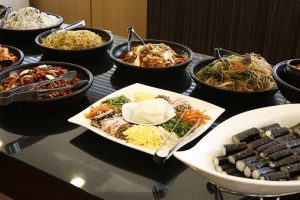I’m not a great cook, but I know what I like. Or do I?
Research from Brian Wansink and colleagues may challenge our ideas about how we think of food. How do we behave at buffets? Can a clever name really encourage us to eat something ordinary? Will placement of food at a cafeteria really make a difference?
After studying behavior of Chinese Buffet pa trons, this research group found that heavier individuals behaved differently from thinner diners. For example, thinner diners faced away from the buffet line, put their napkin on their lap, sat in a booth, took a smaller plate, used chopsticks, and browsed the buffet before serving themselves. Interestingly, thinner diners also left more food on their plates than obese or heavier individuals did at the end of the meal. Why would all of this matter? The napkin and booth behavior suggests that by making it less convenient to get up for seconds or thirds, diners may be able to regulate their food intake. Using a smaller plate and chopsticks and surveying the buffet allow you to monitor how much food you consume, and truly enjoy it, rather than taking a “little bit of everything”. Lastly, if you face away from the buffet line, you are less likely to think about the food and get up for a refill. These little tricks may be worth considering if you often overindulge while eating at unlimited food restaurants. In addition, it gives insight into the mind of an eater. By making a few small changes, people will be less likely to overeat and thus leave the buffet pleasantly full, rather than stuffed. As my young cousin likes to say, “Guess why the turkey left the buffet. Because he was STUFFED!”
trons, this research group found that heavier individuals behaved differently from thinner diners. For example, thinner diners faced away from the buffet line, put their napkin on their lap, sat in a booth, took a smaller plate, used chopsticks, and browsed the buffet before serving themselves. Interestingly, thinner diners also left more food on their plates than obese or heavier individuals did at the end of the meal. Why would all of this matter? The napkin and booth behavior suggests that by making it less convenient to get up for seconds or thirds, diners may be able to regulate their food intake. Using a smaller plate and chopsticks and surveying the buffet allow you to monitor how much food you consume, and truly enjoy it, rather than taking a “little bit of everything”. Lastly, if you face away from the buffet line, you are less likely to think about the food and get up for a refill. These little tricks may be worth considering if you often overindulge while eating at unlimited food restaurants. In addition, it gives insight into the mind of an eater. By making a few small changes, people will be less likely to overeat and thus leave the buffet pleasantly full, rather than stuffed. As my young cousin likes to say, “Guess why the turkey left the buffet. Because he was STUFFED!”
The way that food is described or labeled also affects how we consume it. In another study from this group, they set up an experimental kitchen in which they told people that culinary students worked. In this restaurant, patrons were served a bottle of wine for coming to the restaurant. If the waiter told the diners that the wine was from California, people rated the food and wine served to them as tasting better. However, if the waiter told the diners that the wine was from North Dakota (a region typically not considered a wine producer) the patrons rated the food and wine as being less appetizing. In reality, both wines were the same cheap red wine. Other findings suggest that naming a food something more creative (“Black Forest Belgian Chocolate Cake”) is more likely to get people to buy the same product (“Chocolate cake”). Why is this? It seems that our early evaluations create a sort of “halo effect” over our entire dining experience. A California wine, before one even tastes it, is going to be seen as higher quality than a North Dakota wine. This then affects how you assess the food that follows this wine as being better-tasting after the better evaluated product. Keep that in mind as you eat your vegetables; maybe you should start calling your green side dish “Fresh chopped spinach” or “Zeus’ Greek salad”. It may even make the rest of your meal more appealing!
Finally, Dr. Wansink also recommends placing fruit in a visible fruit bowl on your counter, if you’d like to eat more. Why? Sometimes whatever is most accessible and convenient will be the snack you choose. Dr. Wansink and his colleagues found that just by placing sodas and sports drinks in the back of a cooler behind milk and water, middle school students purchased more milk and fewer sodas. So if you’d like your children to eat more healthy foods, make them accessible. While this will not make it so that children completely stop eating junk food, it may help them add in some better options.
The important information to take away from these findings, is that our eating habits are often driven by much more than our taste preferences. A few simple steps can alter the way we see food, how good it tastes, and how much we choose to eat! This may have great implications for improving the diets of many overweight Americans.
For more information, check out Dr. Wansink’s website.